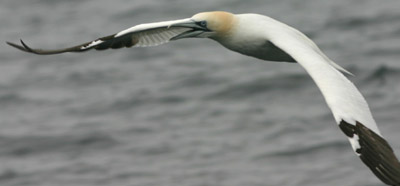For some people, the idea of waking up before dawn to board a boat plying icy winter waters for distant views of ambiguous seabirds DOESN’T sound like fun. What are these people thinking? Clearly, we’re not talking about birders; members of that group usually thrill to the thought of a February pelagic cruise. The Core Team certainly did.
On Saturday, Sara and I embarked on a pre-dawn pelagic voyage out of Long Island, Freeport to be exact. We were joined by a large group of New York City’s most dedicated (and insane) birders, including friends from Hudson River Audubon. We were also pleased to meet Corey, otherwise known as Bad Birdwatcher #1, the winner of our How To Be A (Bad) Birdwatcher contest. Our itinerary involved twelve hours of ocean-faring fun in search of pelagic gulls and alcids. Under cover of darkness, our vessel slipped purposefully into Atlantic waters, heading due southeast along the Hudson Shelf Valley through Chicken Canyon towards an area of deep water known illustriously as the Glory Hole.
In the context of pelagic excursions, this trip, led by Paul Guris of See Life Paulagics, was covered in glory. These kinds of journeys focus not on large numbers of birds, but specific species that only congregate where the continental shelf drops off. The Red-throated and Common Loons we passed on the way out weren’t our goal. Nor did we stop for the Long-tailed Ducks or White-winged Scoters that crossed our purposeful path. These birds could usually be seen from shore in winter, whereas our quarry only appeared in sight of land briefly or by accident. Out in the open water is where these species live, so that’s where we sought them.
The first alcids of the trip were Common and Thick-billed Murre. The former appeared in impressive numbers, but the latter popped up often enough for us to compare the oh-so-subtle differences between the two. Another close relative sharing this territory, the Razorbill, looks enough like the murres to fool most of the population, but sharp-eyed seabirders can differentiate them by their longer tails and deep, presumably dangerous bill.
Though a brief, but breathless look at a single drab, winter plumage juvenile Atlantic Puffin cost us a giddy hour or so, the most celebrated alcid species of the trip was definitely the Dovekie. The adorable Alle alle is a tiny little creature, no larger than a starling. It’s also rather skittish, not at all inclined to sit on the water while an 85-foot boat attempts to sneak up on its starboard side. When we first spotted groups of these birds on the horizon, the tour leaders were thrilled. When a bunch popped up only halfway to the horizon, they cheered that those views were about as good as it gets in the dovekie business. To our great surprise, we did get much closer to many of these petite charmers looking for all the world when aloft like flying footballs. But multitudes of them streamed along the horizon on both sides of our vessel. The proper term for these masses is, no doubt, flocks but ‘swarm’ seems a far more accurate description. At the end of the day, the official dovekie count stood well above 1600, doubling Paul Guris’ previous record and then some!
While the dovekies made everyone else’s day, my favorite bird was the Northern Gannet. We’d only seen these splendid seabirds once before out on Montauk Point. From land, the gannet seems unapproachable, unknowable. When you’re on a boat at sea leaving a chum trail a mile long, the gannets become a lot more accessible. We were accompanied by these birds all day long and were treated to tremendous, up-close looks at every angle. These phenomenal aerialists, marvelously cruciform, with baby-blue beaks, Cheshire grins, and heads the color of toasted almond, even treated us to daring displays of plunge-feeding, their peerless technique of piercing the surf like javelins to reach food well below the surface.
Every swabbee knows that where there’s chum, there’s gulls. An honor guard of Herring and Great Black-backed Gulls escorted our vessel everywhere. Mixed in with the big boys were the occasional Ring-billed, Bonaparte’s, and even Lesser Black-backed, including one of dubious origin. We also got extremely accommodating looks, our first ones ever, at Iceland Gulls of various ages. Our other life gull for the trip, Black-legged Kittiwake, was not nearly as obliging, but present in decent numbers nonetheless.
Birds were not the only sea creatures on our agenda. Pelagic trips offer excellent opportunities for various marine mammals. The first cetaceans of the day were Harbor Porpoise. The most common were, suitably, Common Dolphins, magnificent dark dolphins with pale flanks. The White-sided Dolphins that popped up didn’t seem that different from their common kin, but that may be because they only surfaced for seconds at a time. One species that was easier to pick out was Pilot Whale, bigger than a beluga with a falcate fin.
Our trip was, by pelagic standards, very successful and very smooth. This is not to say that we didn’t hit rocky waves or go for long periods without birds. The last four hours of the voyage was basically full-steam towards home across stormy seas. Few things are less inviting after eight hours of frigid pelagic birding than another four hours at sea, just as cold but absent the prospect of new birds. Such is the sailor’s life. When I look back at this day, though, what I’ll remember won’t be boredom, discomfort, or fatigue. What I’ll remember will be a long, dazzling day of alcids and seabirds out on the open water.

Northern Gannet











Exceptional shot Mike! You are a great photographer.
sam